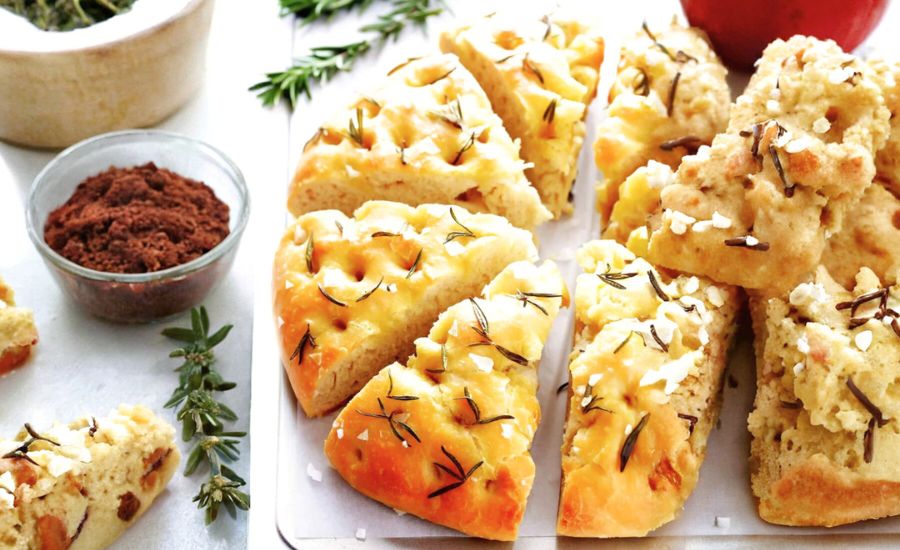All products are selected by our editorial team for quality. If you buy through our links, we may earn a small commission at no extra cost to you.
This Rosemary Focaccia Bread recipe shines with its rustic charm and simplicity, elevated by fresh rosemary and flaky sea salt that infuse each bite with fragrant, herbaceous notes.
Beyond its irresistible flavor, it’s a wholesome option featuring heart-healthy extra virgin olive oil, which provides beneficial monounsaturated fats and antioxidants.
The bread is made primarily from all-purpose flour, delivering satisfying carbs for energy, while the olive oil keeps saturated fat low.
This recipe is also approachable for home bakers, with an option to knead by hand or use a stand mixer, making it great for everyday cooking.
It’s perfect for meal prep or quick sides, offering comforting texture and flavor that pairs with everything from soups to salads.
The slow rises build flavor complexity naturally without added fats or sugars, making it a balanced, satisfying bread choice to enjoy fresh or toasted.
Must-Have Tools for Perfect Results
Stand Mixer with Dough Hook
Essential for effortless kneading, this tool ensures consistent dough texture while saving time and effort.
Beyond focaccia, it’s invaluable for bread, pizza dough, and other baking projects.
Kitchen Thermometer
Precision matters when proofing yeast. A reliable thermometer guarantees water is warmed just right (~110°F) to activate yeast without killing it, ensuring a perfect rise every time.
Parchment Paper
This non-stick baking essential prevents the focaccia from sticking and simplifies cleanup.
It’s also great for roasting veggies, lining cake pans, and more.
9 x 13-inch Baking Dish or Large Baking Sheet
Choose either for shaping and baking the dough. Durable and heat-conductive pans ensure even cooking and golden crusts, making them versatile for many recipes.
Measuring Cups and Spoons
Accurate ingredient measurement is key to baking success, ensuring the dough’s consistency and rise meet expectations.
A kitchen staple for all cooking and baking needs.

Rustic Rosemary Focaccia
Equipment
- 1 stand mixer with dough hook (optional but recommended)
- 1 kitchen thermometer
- 1 large mixing bowl (if kneading by hand)
- 1 parchment paper-lined baking sheet or 1 (9 x 13-inch) baking dish
- Measuring cups and spoons
Ingredients
- 1 ⅓ cups warm water approximately 110°F / 43°C
- 2 teaspoons honey or granulated sugar
- 1 packet 0.25 oz active dry yeast
- 3 ½ cups all-purpose flour
- ¼ cup extra virgin olive oil plus extra for drizzling
- 2 teaspoons flaky sea salt plus extra for topping
- 2 sprigs fresh rosemary needles stripped
Instructions
- Activate the Yeast: Pour the warm water into the bowl of a stand mixer fitted with a dough hook or into a large mixing bowl if kneading by hand. Stir in the honey or sugar until dissolved. Sprinkle the yeast evenly over the surface of the water. Let it rest for 5 to 10 minutes until the mixture becomes bubbly and frothy, indicating the yeast is active.
- Combine Ingredients and Knead Dough: With the mixer on low speed, gradually add the flour, olive oil, and salt to the yeast mixture. Increase the speed to medium-low and continue kneading for about 5 minutes, until the dough is smooth and elastic. If the dough feels too sticky and doesn’t pull away from the sides of the bowl, add up to 1/4 cup more flour gradually. For hand kneading, mix the ingredients until a shaggy dough forms, then turn onto a floured surface and knead for about 5 minutes until smooth.
- First Rise of Dough: Lightly grease a clean bowl with olive oil. Shape the dough into a ball and place it inside the bowl, turning once to coat it with oil. Cover the bowl with a damp cloth or plastic wrap and place it in a warm, draft-free spot. Let the dough rise for 45 to 60 minutes or until nearly doubled in size.
- Shape and Second Rise: Turn the risen dough onto a lightly floured surface. Using your hands or a rolling pin, gently press or roll the dough out to a rectangle or circle about 1/2 inch thick (or thinner if preferred). Cover with a damp towel and let it rest for another 20 minutes to rise slightly again.
- Prepare for Baking: Preheat your oven to 400°F (200°C). Transfer the dough to a baking sheet lined with parchment paper or press it evenly into a 9 x 13-inch baking pan. Use your fingertips to press deep dimples all across the dough, reaching down to the pan. Drizzle 1 to 2 tablespoons of olive oil evenly over the surface. Sprinkle with fresh rosemary needles and a generous pinch of flaky sea salt.
- Bake the Focaccia: Place the prepared dough in the preheated oven and bake for 20 minutes or until the bread turns a golden brown and sounds hollow when tapped on the bottom.
- Serve Warm: Remove from the oven and optionally drizzle with a little more olive oil for extra richness. Slice into squares or strips and enjoy while warm.
Notes
- Salt Substitution: If you don’t have flaky sea salt, fine sea salt works as well. Use roughly half the amount to avoid an overly salty flavor.
- Hand Kneading Option: You can easily make this bread without a mixer. Just mix the ingredients in a large bowl and knead on a floured surface until the dough is smooth and elastic.
- Adjusting Thickness: For a thinner focaccia, roll the dough out more before the second rise. Keep in mind it will puff up during baking, so plan accordingly.
- Rising Environment: For best rising results, place the dough in a warm, draft-free spot such as near a sunny window or inside an oven with the light on.
- Olive Oil Quality: Using good-quality extra virgin olive oil enhances both the flavor and the texture of your focaccia.
Chef’s Insider Tips For Best Focaccia
Mastering focaccia begins with patience and attention to detail.
First, be sure your water temperature is just right when proofing the yeast—too hot can kill it, too cold slows the rise.
Using a kitchen thermometer helps take the guesswork out. When kneading, whether by hand or mixer, aim for a dough that is slightly tacky but not sticky; adding flour sparingly ensures a light, airy crumb.
Don’t skip the double rise — it develops flavor and texture beautifully.
The dimples on the dough are not just decorative but crucial for holding olive oil and seasonings, which infuse the bread during baking.
Fresh rosemary is preferable, but if using dried, crush it lightly to release oils.
Lastly, a generous drizzle of good-quality extra virgin olive oil just before serving elevates the focaccia’s richness and keeps the crust moist and flavorful.
Serving Ideas To Impress Guests
Rosemary focaccia is incredibly versatile and pairs beautifully with many dishes.
Serve warm as an accompaniment to hearty soups, stews, or pasta dishes for a rustic touch.
It makes an excellent base for sandwiches or paninis when sliced horizontally.
For a simple appetizer, cut focaccia into bite-sized squares and top with tomato bruschetta, fresh mozzarella, or roasted vegetables.
It also pairs wonderfully with cheeses and charcuterie boards, adding an herby, savory note.
For a light meal, enjoy it dipped in flavored olive oils or balsamic vinegar.
Leftover focaccia can be toasted and used as croutons in salads or soups, giving you more ways to enjoy this delicious bread.
Best Practices For Storage Tips
To keep your focaccia fresh, allow it to cool completely before storing to avoid condensation, which can make the crust soggy.
Wrap the bread tightly in plastic wrap or place it in an airtight container at room temperature for up to 2 days.
For longer storage, freeze focaccia wrapped well in plastic and then aluminum foil to protect against freezer burn; it can be kept frozen for up to 3 months.
To reheat, thaw at room temperature, then warm in a preheated oven at 350°F (175°C) for 5–10 minutes to refresh the crust and soften the interior.
Avoid refrigeration, as it tends to dry out bread quickly.
Proper storage preserves flavor and texture, so your focaccia stays delicious beyond the day it’s baked.
Frequently Asked Questions Answered Clearly
1. Can I substitute all-purpose flour with whole wheat flour?
Yes, you can substitute whole wheat flour for a healthier, nuttier focaccia, but expect a denser texture. Use about half whole wheat and half all-purpose for best results.
2. How do I know if my yeast is still active?
Proof your yeast by mixing it with warm water and sugar. If it becomes bubbly and foamy within 10 minutes, it’s active. If not, it’s time to get a fresh packet.
3. Can I prepare the dough ahead of time?
Absolutely! You can refrigerate the dough after the first rise for up to 24 hours. Bring it back to room temperature before shaping and the second rise.
4. What’s the best way to store leftover focaccia?
Store at room temperature in an airtight container for up to 2 days or freeze wrapped tightly for longer storage. Reheat in the oven to restore freshness.
5. Can I add other toppings besides rosemary?
Definitely! Try sliced olives, cherry tomatoes, caramelized onions, garlic, or Parmesan cheese. Add toppings just before baking for best flavor.
This recipe is inspired by gimmesomeoven and has been carefully refined to enhance clarity, streamline preparation steps, and ensure accurate results. We’ve also included health benefits, nutritional highlights, and Must-Have Tools to help you get the best results every time you cook.


